If you see:
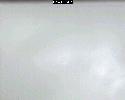
Click on Image -
[14K,JPG]
|
Most Likely Explanation:
Mount St. Helens is located in the Pacific Northwest where is has either just
stopped raining, is currently raining, or is getting ready to rain.
The elevation of the camera site is
approximately 4,500 feet, is located approximately
5 miles from the volcano, and looks across the North Fork Toutle River Valley.
This is an area which gets over 100 inches of rain a year.
Most likely, you are looking at rain, clouds, fog, and/or a
combination of the three.
|
If you see:
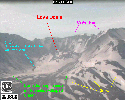
Click on Image -
[175K,GIF]
|
You are looking at:
The horseshoe-shaped crater of Mount St. Helens opens to the north. From the
Johnston Ridge Observatory VolcanoCam you can see into the crater and see
Mount St. Helens' Lava Dome.
In this image a small rockfall-mudflow track
from melting snow mixing with crater wall debris is visible on the east crater
wall and floor. Mudflows like these are common in the spring and early summer.
|
If you see:

Click on Image -
[206K,GIF]
|
You are looking at:
The Johnston Ridge Observatory's VolcanoCam's "wide-angle" view of Mount St.
Helens showing not only the horseshoe-shaped crater and Lava Dome, but also
the Pumice Plain and the North Fork Toutle Drainage in the valley below.
|
|
The Image Looks Funny - What Gives?
|
If you see:

Click on Image -
[20K,JPG]
|
You are looking at:
There is a cloud layer between the camera and the volcano. This cloud layer is
high enough so the base of the volcano (the bottom 1/3 of the
picture) is visible, but low enough to obscure the view of the volcano's top.
These types of cloud layers often come and go, so try the VolcanoCam a bit later.
|
If you see:
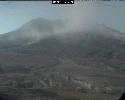
Click on Image -
[46K,JPG]
|
You are looking at:
Often when a brisk wind blows during the dry summer months, loose
ash in the crater gets blown about, creating "windblown dust plumes".
The light-colored "haze" you see is that windblown dust.
On this particular day that "plume" was reported to reach 9,000 feet
(more than 700 feet above the crater rim).
|
|
Can You Show Me A Nice Picture?
|
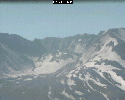
Click on Image -
[25K,JPG]
|
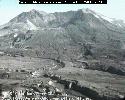
Click on Image -
[25K,JPG]
|
|
|
|
The Camera Has Changed Views - Why?
|
If you see:

ZOOM
Click on Image -
[23K,JPG]
|
If you see:
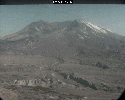
WIDE-ANGLE
Click on Image -
[58K,JPG]
|
|
|
|
The "zoomed" view lets web-tourists see a closeup of the volcano. The
"wide-angle" view give folks an idea of what the weather is doing before they
drive up to the visitor center. Each view has its merits.
If you prefer one over the other please let the U.S. Forest Service know.
The U.S. Forest Service, Gifford Pinchot National Forest maintains the "VolcanoCam"
and would appreciate any input on the camera you wish to express. To do so,
go back to their pages and click on "Feedback" found in the frame
on the top of the page.
|
|
What Does The Camera Look Like?
|

Click on Image -
[51K,JPG]
|
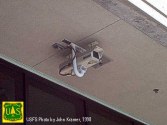
Click on Image -
[66K,JPG]
|
|
|
|
What Does The Camera Show Today?
|
-
-
 Link to: VolcanoCam
Link to: VolcanoCam
-- "Live" view from Johnston Ridge Observatory.
-- Link courtesy U.S. Forest Service,
Gifford Pinchot National Forest, Mount St. Helens National Volcanic
Monument
|
I have a Question about the Camera - Who do I Contact?
|
-
 Please contact the U. S. Forest Service
Please contact the U. S. Forest Service
The Mount St. Helens National Volcanic Monument is within the jurisdition of the Gifford Pinchot National Forest (USFS). For any
questions, information, or problems with the "VolcanoCam" please contact them (click here, then click on "feedback" on the top of
their page) and NOT the Cascades Volcano Observatory. Thanks.
|

